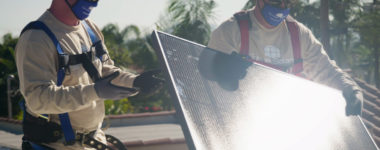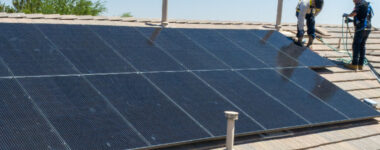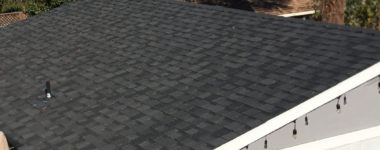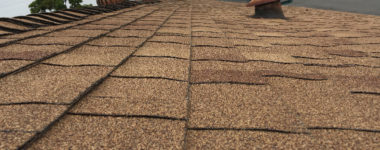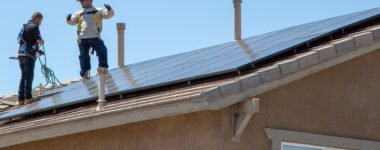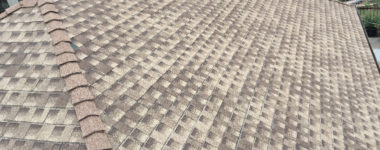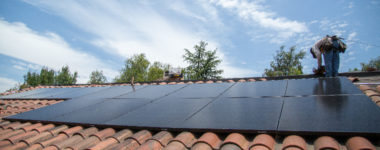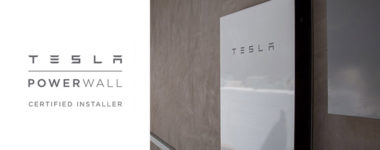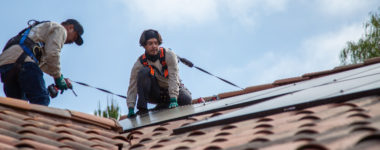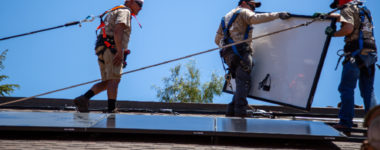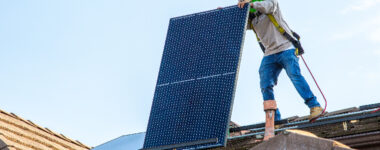Semper Solaris Blog
There is a lot to consider when it comes to selecting the right roofing material for your home in Bakersfield. Your roof plays an important role in protecting your home from the natural elements. It also increases the value of your home depending on its insulation quality and appearance. What all started with just banana leaves and haystacks to prepare a shelter from the rain and sun has now emerged as an industry with an extensive range of products. Roofers now offer materials and styles like natural slate and wood to man-made products such as asphalt, sheet metal, and plastic polymers. What type of material is used to roof your home is not solely based on aesthetics, while that is important what climate you are in also has a lot to do with it. So these are the best types of roofs for the climate in Bakersfield. Metal Roofing Metal roofing was generally used for warehouse construction in the past, but with advanced technological changes, many people are choosing metal roofing for their residential homes. They are available in copper, aluminum, and stainless steel with a high percentage of recycled content. The look varies from traditional metal roof panels to simulating wood shakes and shingles, slate, or tile. Metal roofing is lightweight, fire resistant and durable. Apart from its longevity, it is much lighter than most materials and resistant to adverse weather. Wood Shingles and Shakes Wood shingles and shakes are available in different qualities of wood like cedar, redwood, southern pine. Shingles are made with the help of a machine whereas shakes are handmade and have a rougher look. Since this type of roofing is more aesthetically appealing due to its natural appearance, it’s much more expensive than asphalt. However, in recent years, its use has been a concern due to its lack of fire resistance and the potential of mold in heavy rainfall. These shingle and shakes have been categorized underclass ‘A’ and ‘B’ according to the character of the specified. Class ‘B’ products have been pressure treated with fire retardants and are readily available. Asphalt Shingles Studies show that more than 75% of Americans choose this roofing material because of its low cost, easy installation, and resiliency. These are made of fiberglass mat which is saturated with asphalt and coated with colored mineral granules. They have low insulation quality and a shorter lifespan than any other roofing material. Standard shingles are available in a wide variety of colors and are the cheapest option in roofing material. Clay and Concrete Tile Clay tile is made from natural clay which is fired in a kiln whereas concrete tile is made from a mixture of Portland cement and sand. These tiles give comparable benefits to slate but with a greater variety and at a lower cost. Tile is very durable and fire resistant but it’s much more heavy and expensive than other materials like asphalt shingles, fiber cement products, so your roof may require a reinforcement if you are planning to go for tile roofing. Slate Slate is a dense natural material that is non-absorbent. Its color is determined by its chemical and mineral compositions. As we know these factors vary from place to place, slate is available in a variety of colors. These factors also influence the responsiveness of slate towards changing color upon exposure to weather. Those with minimum change in color are known as ‘’permanent’’ slates while those with the most color changes are known as “weathering” slates. Reroofing with slate will require reinforcement of the roof to carry its heavy load. Although it’s non-leaching and lasts for hundreds of years and its natural beauty is unparalleled, it is one of the most expensive of steep slope roofing materials. Its installation is labor intensive and requires considerable skills.
You've likely noticed the explosion of solar energy systems appearing all over the place in recent years. Solar farms are appearing across the United States, and many people are choosing to have solar energy systems installed at their home and business locations. Still, plenty of people haven't subscribed to the solar energy idea yet. If this point describes you, you may want to consider some of the benefits you may enjoy if you had a solar energy system installed. Below are five specific benefits of solar energy systems for your Bakersfield home and how they will enable you to get the most out of such an upgrade. Solar Energy Systems Save Money First and foremost, remember that solar energy is free. The sun shines several hours a day, every day of the year, especially if you’re in Bakersfield. So you can save a tremendous amount of money by having a solar array on your home that captures that free energy whenever the sun is out. The best solar energy systems can pay for themselves in just a few years, reducing what you spend on energy immensely. With Solar in Bakersfield, You Aren’t Dependent on Energy Companies A major benefit of solar energy systems is that they allow you to cut the cord from the electric companies. It’s a necessity that you’ve been using your entire life, so you likely never thought of it, but you are completely reliant on a company that can change rates, alter availability, or suffers outages outside of your control. With solar panels, you can own your electric source and not need to rely on such a company ever again. Solar Energy is 100 Percent Renewable This is the big one, the reason this is such an incredible potential energy source for so many people in Kern County and other year-round sunny locations. Solar energy is renewable. It’s never running out. Fuel prices, wars, and commodity shifts—none of it will affect the cost of your electricity if you have solar panels installed on your home. Benefits of Solar Energy to the Environment Right alongside renewability and sustainability comes another important factor: New solar energy systems benefit the environment in the form of a heavy reduction in CO2 emissions. Almost every other form of major electricity production in the United States burns fossil fuels. With solar panels on your home, you won’t be contributing to what is becoming an increasingly dire situation. Better yet, you’ll be able to help by producing your own electricity. Get Paid for Your Energy With the right solar panel array on your home, you may produce more energy than you actually need. This can result in Solar Renewable Energy Credits that can then be sold for cash. That’s right, you can actually earn tax credits and rebates for installing new solar panels on your home! If you remain on the grid, you can feed back into the system as well so that when you underproduce your needs, it balances out against what you’ve given to the grid. Is Solar Energy Right for You? The benefits of solar panels are plenty, including freedom from the energy grid, a chance to do your part to help the environment, and a way to both save and possibly even earn money. It’s a perfect fit for anyone looking for a substantial upgrade for the home with long-term benefits. Above are just a few of the many amazing benefits associated with solar energy systems. If you’d like more information on solar panels for home use, don’t hesitate to contact Semper Solaris.
You may think summertime is the best time to repair a roof, but the autumn months are preferred. In bright sunny Orange County, roofing projects can be extremely hot and dangerous in the summertime. A crisp fall morning is a much better time to undergo a roofing project to prepare for winter, and your roofing contractor will thank you as well! Orange County Winters Although it never snows in coastal OC towns such as Newport Beach or Huntington, it still gets windy, and there’s still a little bit of rain. Completing a roofing project in fall is a great way to prevent any issues you may have with an old roof in the wintertime - i.e. leaks, pooling water or rotting asphalt shingles. If you have any broken shingles, they will only get worse in the winter and those few broken shingles may compromise the integrity of your entire roof as well as your attic space. Furthermore, a new roof will save you money on your utility bill. That’s right: OC homeowners often forget that a roof is more than just a set of shingles. Getting a new roof in the fall will help insulate and ventilate your home before the colder winter months. This could save you money in the long run by allowing your furnace to not have to work as hard. You’ll also be saving money year-round because a well-insulated home will offer the same benefits for your AC in the summer. Fall has the Perfect Temperature for Roofing Projects As we’ve mentioned before, Orange County summers are hot. The heat offers more issues than just a tough time for workers though. Hot weather can also warp asphalt shingles and cause issues with properly fitting your roofing materials together. That’s just another big reason why fall is the best time to install a roof for Orange County residents. Contact Semper Solaris today to make sure your home’s roof is ready for winter. Our team of expert roofers is local to the Orange County area and we take great pride in offering the best roof replacement services in OC.
With its year-round gorgeous weather and more than 800 miles of superb coastline, it’s no wonder that California is a boating Mecca. According to a 2002 study by the U.S. Coast Guard, California is the number one boating state, boasting over one million registered boats within its borders. (Fun fact: California contains more boats than South Dakota does people!) Of course, Californians will put their own spin on boating. That’s why more and more Golden State boaters are installing solar panels on their floating castles to improve their life at sea and to protect the fragile ocean beneath their hull. Are you considering solar panels for your boat? You probably have a lot of questions, like do solar panels make sense for boats? How do they work on boats? Where in the world do they go, and what are the unique challenges of going solar on the open water? In this article, we answer your most pressing solar questions, so you can decide whether to add some solar power to your flagship. Does Solar Make Sense on Boats? We Californians love our solar panels. Stroll through any subdivision in San Diego, Sacramento, San Francisco, or Oakland, and you’re bound to see the gleam of panels on many rooftops. In fact, our state is crushing on solar panels so hard, California recently announced that most new homes and structures built after 2020 must incorporate solar panels. How does this solar crush translate to the sea? Does it really make sense to tether a few panels to your boat? The answer, increasingly, is yes. You may have heard horror stories from wizened sailors of rusted or cracked first-gen solar panels that couldn’t even keep a lightbulb on for an hour. However, over the past decade, solar panel technology and manufacturing has improved by leaps and bounds. These days, solar panels are much cheaper and more powerful. Best of all, they are both sturdy and flexible, allowing them to survive all the pitches and rolls that come with a life on the high seas. As a result of these improvements, more and more sailors are inviting solar on board. What does that actually look like, and how can solar panels power your through the waves How to Use Solar Panels on Your Boat Battery Recharge There are two primary ways to utilize solar panels on your boat. The most common (and until recently, only) option is to use solar panels to recharge your ship’s batteries so that you can run all the electronics on your ship without having to periodically turn on your engine. This is a convenience that lets you charge your tablet, keep your drinks chilled in the fridge, and enjoy lights at night without having to turn on your noisy engine every few hours. Your neighbors in the marina or in the peaceful cove where you’ve dropped anchor will appreciate the extra peace and quiet. Can this type of setup actually work? According to Emily Fagan, she and her husband Mark relied on solar panels to keep the batteries charged on their 2008 Hunter 44DS named Groovy almost exclusively during a nearly four-year cruise around Mexico. Fagan even recalls that they were forced to rely only on solar power for ten weeks while they waited for an engine alternator replacement. “We had no backup charging system to turn to, and yet we lived and sailed comfortably the entire time,” Fagan writes. The beauty of rigging solar panels to charge your ship’s batteries is that you don’t need a significant amount of solar power to do the job. Since solar prices have fallen over so much in the last decade, this retrofit is highly affordable for most boaters! Sailing on the Sun More recently, a small but growing number of sailors have started to sail using solar power. In 2017, Captain Jim Greer completed the “Great Loop,” a 7,200-mile cruise through the Great Lakes, inland rivers, and the Atlantic Ocean, on his 48-foot tri-hull named Ra, using only solar power. (He didn’t even power up at the marinas.) His boat didn’t exactly break any speed records – he recorded a top speed of 10.7 miles per hour – but he made the entire trip without using a drop of fossil fuels. This was made possible by using solar-charged batteries. Boaters who want to preserve the beautiful oceans and waterways that keep them afloat may now be able to cruise those waters while burning less or even no diesel gas at all! Whether you want to dip your toe into the solar waters by installing a system that charges your electronics or you’re ready to sail the world using only solar panels, how do you actually incorporate solar panels onto your boat? Adding Solar Panels to Your Boat Thinking about adding solar panels to your flagship? Your first step is to decide whether you want the solar panels to power just your electronics or your whole ship. If you’re looking to sail just on solar alone, be ready to invest in a hefty solar power system. You should also be the type of person who loves planning – you’re going to need to keep a close eye on your batteries and make sure you always have enough juice to stay safe! Like most sailors, you want to start with the smaller goal of using solar to power your on-board electronics, your next step is to calculate your energy needs. That sounds harder than it actually is. Simply determine the energy requirements of each piece of electronic equipment on your ship, including the things you want to regularly charge. For example, you should be able to figure out how many watts your phone requires per charge or how much energy your fridge and freezer take to run for an hour. Next, determine how much you typically use each item. If you just like to take your boat out of the San Diego harbor for half a day on the weekends, you won’t need nearly as much power as you would if you plan to live on your boat full-time, like Emily and Mark Fagan. Your energy needs will help you determine how many solar panels you’ll need to purchase and what type of panels will be best for your boat. Finding the Space One of the biggest challenges of incorporating solar panels on a boat is finding the space to install them. Unless you are captaining a luxury yacht, space is likely to be at a premium. While solar panels have gone down in size over the past decade, they still take up space. The best option for you will depend on the dimensions and layout of your boat. Obviously, the smaller the boat, the more difficult it will likely be to find space for panels. Some sailors have solved this problem by crafting overhead structures or racks on which to place panels. Others have placed solar panels on the sides of the boat, embedded them in the deck, or purchased foldable panels that they can take out and reposition around the ship. It may be a good idea to work with an experienced solar installation company to determine the best ways to safely and effectively incorporate solar panels onto your boat. This is especially true because where you place the solar panels can dramatically impact how well they perform! Avoiding the Shadows Anything that blocks the sun’s photons from hitting your panels can dramatically lower the energy your panels produce. Besides the unavoidable clouds in the sky, homeowners generally don’t have to worry about bothersome shadows when they have solar panels installed on their rooftops. Boat owners face a more difficult challenge. Between the mast, sail, spreaders, boom, and the radome, solar panels on a boat often get hit with energy-dampening shadows. To make things even more complicated, the shadows will change depending on the heading and location of your boat, which changes by the second! When it comes time to install your solar panels, be aware of how shadows could affect your system’s energy production. Try to install the panels in a way that avoids the most drastic shadows and consider purchasing more solar panels to offset any restrictions that may come from unavoidable shadows. Install Your Own Solar Panels or Hire a Solar Installation Expert? Once you’ve decided to take the solar challenge, you’ve got one more important decision to make. Can you install the solar panels on your own, or should you hire a licensed expert to help? The right answer will be different for each boat owner Many boat owners pride themselves on their independence and could enjoy the challenge of wiring up their own solar system. Certainly, if you only want to dabble with a smaller system or even start with a portable solar panel setup to recharge a few of your devices each day, you can probably handle the installation yourself. For larger installations, however, it is usually best to work with an expert team. A licensed solar installer can help you determine which type of solar panel would be ideal for your boat and would hold up best on the open water. An experienced California solar installer may also be able to either build a new structure on your boat to support the solar panels or hire a subcontractor that specializes in this type of work. Most importantly, a solar installer will ensure that your system is designed and installed correctly so that you don’t accidentally damage your boat’s batteries and so that the system doesn’t underperform due to shadows. If you’d love to drift along a quiet cove without turning on your boat’s engine every few hours to charge your battery, or if you dream of cutting your carbon footprint to protect the ocean and all its amazing inhabitants, contact Semper Solaris. We are a California solar installer that understands the call of the open sea. Let us help you add a little sun to power to your boat. Contact for a free solar consultation today.
When it comes to roofs, there are a wide range of options to select from. You’ve got everything from TPO for many commercial buildings to classic shingle for residential homes. Materials can range from metal to wood to cement to plastic to clay. What makes one material more preferred over the other? It can vary greatly based on the use of building, geographical location, weather, budget, and style. So what are some of the most common types of roofs that can be found in the Bay Area? We break down the region’s most popular roofing options. Keep reading to find out more! What Type of Roof Do You Have? Wondering if your roofing material makes it in the top four most common roofing materials? Check the list below to learn more about your home’s roofing material or other options available to you. Here are some of the Bay Area’s top roofing materials: Slate: The pristine, elegant beauty of slate has been proven reliable for homeowners time and time again. Weather-resistant, slate roofs boast a lifespan ranging from 80 to 100 years. The natural appearance of slate lends itself to many different patterns and styles, making it a diverse roofing material. Slate tiles are also fire-resistant and rather easy to keep looking good for years to come. Clay / Terracotta: As a very common option found throughout California, clay (or terracotta) tiles exude Mediterranean or Spanish style. Due to the durability of clay, it is a very popular selection -- it can withstand fires, rot, and even insect pestering. Another feature that makes clay tiles so common is the range of colors and styles available. You can customize these details to best suit the style of your home, making them very versatile. Wood Shakes: Though they are a little more susceptible to fire damage and rot than other roofing materials, wood shakes provide great insulation and air circulation for homes. This style of roofing can come in numerous colors, wood types, and patterns, making it ideal for customization. Wood shake roof designs can look anywhere from rustic chic to old world romantic. Composite Shingles: As one of the most affordable roofing materials, composite shingles can be used for a range of different home types. Homeowners often have a broad selection of colors and styles of shingles, even recycled shingle options. Other options include fiberglass and asphalt. Ready to Upgrade Your Roofing? Schedule Replacement! Whether you have a slate roof or clay shingles, if your roof is in serious need of replacement, leave it to the pros at Semper Solaris. Why consider a roof replacement? Not only can an upgraded roof better protect your home and personal property, but it can also add to the value of your house. A sturdy roof means peace of mind and boosted curb appeal. If you’ve considered going solar, having a stable, strong, and reliable roof is all the more important to complete your home improvement project. Interested in learning more about our roof replacement in the Bay Area? We are here to help. Contact us today to get informed.
Solar has grown immensely in Inland Empire and steadily in the past 5 years. The introduction of ITC (Investment Tax Credit) has been the single biggest driver in encouraging homeowners to go solar – it has made the costs of solar come dive by whopping 70% since it started in 2006. Besides the federal tax credit system, there’s a myriad of other financing options and net-metering. These options help homeowners with the upfront costs, but net metering also allows some owners of residential solar manage to cancel out their utility bills. US solar capacity has risen by around 2.7 GW (around 4.6 million homes) and in the second quarter by around 1.4GW, marking a milestone for the States because now there are over 20GW of solar power coast to coast. Unfortunately, it’s not likely they will. The current SCE net metering system gives Inland Empire homeowners an opportunity to zero out their bills in the next 20 years. Going solar as soon as possible will allow homeowners to invest more money into their PV system before tax credit funds run out. It will also be possible to have the system installed for the smallest possible budget, since the price of materials and installation itself will jack up when the tax credit system runs out. A third of the costs covered by the government is quite a relief for your wallet. Plus, you’ll be able to cancel out your utility bills or significantly reduce them for the period of next 20 years. And one more reason why it’s better to go solar sooner rather than later – an increased demand is expected to take place quite soon as people start to realize solar is the most affordable just now. A larger demand entails longer waiting periods – so the sooner you jump on the bandwagon, the sooner you’ll have clean solar energy for your home. If you are considering going solar in Riverside, CA, or anywhere in the Inland Empire, don’t hesitate to call Semper Solaris for a quote. We are ready to answer all your questions and provide you with the most accurate information regarding residential solar, so you can make an informed decision. Our veteran-owned and operated company is based on trust, premier products, and first-class workmanship. We deliver what we promise. Contact us today!
While typically found on commercial roofs, some more modern or minimalist home designs may also feature flat roofs. Flat roofs are very popular in the Bay Area, primarily due to the influence of famed architect Joseph Eichler, who promoted affordable midcentury-modern designs in San Francisco and surrounding areas. With that stylized look comes a little more maintenance and upkeep than your average roof. One of the biggest challenges is determining if your roof just needs some repair work or is due for a major replacement. This becomes even tricky to determine when you have a flat roof. The good news? We’ve outlined a few of the most common problems that indicate its time to have your roof inspected or worked on. What to Keep an Eye Out For Water Puddles or Pools A typical roof has a slant to it to prevent water from building up anywhere. Flat roofs don’t have this advantage. With exposure to the elements, your roof can begin to develop some dips or uneven spots. Since that rain or snow really has no natural runoff point, these areas could begin to collect water. While your roofing materials are likely designed to withstand rain and snowfall, it is still good to inspect for pools a day or so after rain and ensure these spots are drained quickly to avoid deterioration at all. To avoid these spots, some additional repairs may be required. Buckling Membrane A flat roof will typically have an asphalt membrane that is laid across the roof space. While initially flat, the natural movement and shifts of your home will cause some wear and tear to that membrane. If there is an excessive amount of shifting, there could be buckles in the membrane. This is a serious structural issue that requires immediate inspection. Most likely, a buckling membrane indicates is time for a roof replacement. Roof Cracking or Bubbling Often referred to as “alligatoring,” a flat roof that begins to crack and bubble (resembling an alligator’s skin) is a telltale sign that a roof replacement is on the horizon. Why does this occur? Roofs that are flat don’t have the natural give that slanted roofs have. Over time, the build-up of pressure can cause the asphalt on your roof to lose some of its elasticity, eventually deteriorating so badly that a replacement is the only option. Leaks or Water Stains This is an easy problem to spot -- and one of the most common to plague flat roofs. Moisture spots or leaks can not only be threats to the structural health and integrity of your roof, but also the interior of your home. Thankfully, these types of issues are generally pretty straightforward and easier to resolve without replacement. However, due to the flat shape, moisture doesn’t run off as naturally, so it is important to handle leaks as soon as you notice them try to prevent mold and fungus developments. Flashing Issues Your roof is exposed to the elements 24/7. That means it will endure natural wear and tear over the years. Flashing issues can develop when your flat roof begins to expand and contract due to this exposure and temperature swings. The flashing may start to peel away, exposing corners of the roof to the elements. This means the threat of leaks, mold build up due to unchecked moisture, and other complications. Have Roofing Problems? Semper Solaris is proud to offer reliable roof replacement in the Bay Area. If you are concerned about some problems you notice with your flat roof, don’t hesitate to contact our skilled roofing professionals today.
What happens when you have too much of a good thing? Easy, you share the wealth with your neighbors. In this case that “wealth” is California solar power, and California has so much of it, including solar power from Los Angeles, that it has been giving some of that sunshine goodness away to neighboring states, like Arizona and Nevada, for years! How has our state and our big cities like Los Angeles produced so much solar power that they need to give it away (and in some instances actually pay other states to take it)? Is there a way for our state to better utilize our solar energy so we don’t have to send it to neighboring states? Let’s shine a light on these questions and see if we can find some answers. California’s Aggressive Solar Push California has long been a renewable energy leader. The Golden State passed Senate Bill 350 in 2015, which requires all utilities in the state to source half of their electricity sales from renewable sources. That obviously wasn’t enough of a stance against carbon-heavy fossil fuels. Earlier this year the California Energy Commission unanimously adopted standards that require solar panels on most new homes and buildings created after January 1st, 2020. In other words, California is betting big on renewable energy, especially solar. The results have been impressive. In 2010, California’s power plants generated just 15% of their energy from renewable sources, which were mostly wind and geothermal power. By 2017, that number had risen to 27%, almost all of the increase coming from solar. Additionally, in 2017 Pacific Gas & Electric relied on solar for 13% of its power, whereas San Diego Gas & Electric utilized solar for 22% of the energy it provided to its SoCal customers. Where is all of this solar energy coming from? If you were to jump on a plane and scour the state, you’d come across some of the world’s largest solar farms spread out in California’s desolate inland, including the Topaz Solar Farm (550 megawatt capability) in the Central Valley, as well as the Ivanpah Solar Power Facility (392 megawatts) and the Beacon Solar Project (250 megawatts) in the Mojave Desert. These major facilities combine to provide over 1,000 megawatts (MW) of solar power capability for the state. Of course, you don’t even need to rent out a plane to see how solar is transforming California. You can see the increase in solar power in Los Angeles just by taking a jog around the neighborhood and counting up all the homes with solar panels on their roofs. With this rapidly increasing solar capacity, it’s no surprise that California is making gains toward it’s renewable energy goals. What is surprising is just how laughably easy that goal seems now. The state has already easily surpassed its first milestone of generating 25% of its energy from renewable sources by 2020, and we might even hit the entire goal of 50% renewable energy production ten years early. This is where too much of a good thing might actually become a problem. California has started to generate so much solar power so quickly that the state’s existing infrastructure is scrambling to adapt. In the short term, this has meant handing off some of our solar power to our neighbors and even in some instances begging them to take it! Why California Doesn’t Use All of Its Renewable Energy To understand why California is giving away solar power from Los Angeles and its other big cities, we must take a step back and look at the bigger picture. The California Independent System Operator (CAISO) is the state entity in charge of running that state’s massive electrical grid. One of its prime directives is to prevent blackouts and brownouts, which have plagued California in the past. California generates energy from a wide variety of sources, including from natural gas plants. It’s up to CAISO to figure out how to use all of this incoming energy effectively. The rise of solar power has made this balancing act more difficult. That’s because solar power is not a consistent energy source. During long, sunny days in the summer, solar energy can surge. At night, or during a stretch of cloudy days, the amount of available solar power can drop precipitously, forcing the state to rely more heavily on natural gas plants and other power sources. The biggest energy glut typically comes in the winter, when power usage is low but solar energy production remains high. (In the summer, the heavy use of air conditioning across the state eagerly sucks up excess solar energy.) To some degree, California has the ability to turn off its solar tap. CAISO can ask its utility companies to cut back their solar energy production. Still, this isn’t always enough to manage the incoming energy supply. After all, the utilities can’t turn off the growing number of residential solar power systems. Why not turn off the natural gas plants during sunny days when solar energy production jumps? That would certainly be a better deal for the environment, but not for California’s budget. It is costly to stop production at natural gas plants, which means solar plants are usually the first target for energy cuts. In some cases, even cutting back on solar power isn’t enough to stem the flow of too much energy production. If too much power goes through California’s electrical grid, it could cause a brownout or blackout, almost like allowing too much steam to build up in a closed system. When this situation occurs, CAISO has to find a way to release the pressure and get rid of the excessive energy. It turns out that sharing really is caring! CAISO often turns to California’s neighboring states to offload excess energy. According to an article in the Los Angeles Times, California paid Arizona to take its solar power for eight days in January of 2017, nine days in February, and 14 days in March! Arizona isn’t the only beneficiary of this largess. California has also been known to give its solar power away to Nevada and other neighboring states. Why Does California Have to Pay for Its Neighbors to Take Its Energy? You’d think that Arizona and the other states would be happy to get free energy. However, it’s all about supply and demand. If Arizona needs energy, it might be willing to pay California for its excess or accept the energy for free. However, if Arizona is producing enough energy on its own, it will actually need to turn off its own energy valves in order to take California’s energy, which costs it money. In other words, when California desperately needs to get energy off its hands and no one wants it, we have to pay up! This seems like a bizarre state of affairs, doesn’t it? California has gotten too good at producing solar power. How can our state figure out a way to actually use all the solar power it produces? How to Keep Solar Power in Los Angeles One answer is for California to slow down the pace of or entirely stop greenlighting new natural gas plants in the state. Surprisingly, until relatively recently, state regulators have been giving the thumbs up for new natural gas projects. Some utility officials claim that new plants are needed to stabilize the grid, especially at night or during cloudy days when solar power isn’t available. However, the state is home to plenty of existing natural gas plants, and many activists believe new ones aren’t needed. Instead, they want California to focus on finding better ways to harness solar energy. That has everything to do with improving the way solar energy is stored. Reliable and efficient solar energy storage would allow California to keep all the excess solar power it produces on sunny days (or at least much more than it currently does) and feed that energy back into the electrical grid at night or during cloudy days. Fortunately, solar storage technology continues to improve at a rapid pace. For example, solar panel batteries like Tesla Powerwall are getting better and cheaper each year. Soon, effective solar storage systems may help eliminate some of the largest challenges of solar, which could, in turn, allow California to fully embrace its growing solar infrastructure without sending its solar energy out of state. Last year, California Senate President, Kevin De León, introduced a measure that would have required California to produce 100% of its energy using renewable resources by 2045. That measure was narrowly defeated, but de León vowed to bring it up again. If this measure is adopted, California will likely have to increase its solar production capacity even more and find an effective storage solution. You can help be part of California’s solar solution! If you want to see our state transition to 100% renewable energy, then now is the time to invest in solar panels for your home. Contact Semper Solaris today to request a free home energy analysis.
Under California’s new energy storage mandates, SDG&E is required to create solar battery storage facilities for a total of 331 megawatts. So far, SDG&E has been granted approval for 5 facilities, which will cover about 83.5 megawatts, while currently a 30-megawatt battery storage center is already in function. The locations for the facilities include Escondido, Poway, San Diego, Fallbrook, and San Juan Capistrano. Why are California policymakers pushing for solar energy storage? Currently, renewable energy faces challenges with intermittency—or consistency due to limited hours of sunlight or a lack of wind. While overall reliable, there is some issue with slumps in power. On the other hands, sometimes there is an overproduction of renewable energy without enough immediate demand to use up the energy created, which has forced California Independent System Operator to face the decision of sending this unused power to other states—or even curtail the production. The solution? Create battery storage facilities to store the power rather than give it away or shut it off. This allows cities to capitalize on more production during peak times and rely on reserves during the lulls in energy production. Ultimately, the goal of battery storage facilities is to help reduce California’s (and other states taking this approach) dependency on natural gas, which still holds a major grip on the state’s electric generation. Are Battery Facilities the Right Answer? While policymakers are onboard for battery storage facilities, promoting projects across Southern California, not all people share this viewpoint. Some skeptics believe that current energy storage technologies are too expensive an investment. This mindset doesn’t take into consideration the current challenges of overproduction during peak hours (and loss of that overproduction due to lack of storage or usage), as well as issues with over-demand during lulls in solar production. Though the cost may be several cents higher, the reality is that over time, prices can be driven down with better technology and efficiency. In addition, there are other benefits to consider when it comes to renewable energy storage. What makes battery storages facilities beneficial: Enable the local grid to be more resilient Improves reliability and accessibility of renewable energy Provides a safety net or resource to be drawn upon in emergencies Allows cities to take full advantage of solar and wind production Investing in technologies now could mean a brighter, better future Altogether, these benefits point to the reason California policymakers are pushing for storage facilities and calling upon utility companies like SDG&E to pick of the mantle in this area of renewable energy. Energy Storage Technology Helps Fill in the Gaps While there is still some debate about the cost-benefits of solar battery storage, the reality is that the technology is still new and continually improving. The more the use of solar battery spreads, the more the technology will become more affordable and accessible. That means with more and more residents in San Diego going solar, the state will be able to better capitalize on solar energy production. Where previously California would have to funnel energy out to other states during excess times, the battery facilities will now allow more of that energy production to be kept in the state and used for dips. The battery facilities will ideally continue to become more affordable over time, becoming a practical way to store up the “harvest” of solar power during the sunniest of days so that homes can draw upon these reserves when needed. Essentially, solar battery facilities help fill the gaps in energy needs and demands so that renewable energy sources can be used more widespread.
When people think about San Francisco, they often see it as a trailblazing city -- home to some of the most innovative companies and forward-thinkers. It should come as no surprise then that the city has been leading the way on the renewable energy front. City leadership has been very vocal about its ambitious goals for San Francisco, especially when it comes to renewable energy. Mayor Ed Lee has made it his mission to push the city ahead, aiming to have 50% of the city’s electricity needs covered by renewable energy production by 2020 -- a decade ahead of California’s goal. As of 2017, the city was getting 44% of its electricity from renewable sources like wind turbines and solar panels. That leaves a 6% difference to make up, which is no small feat. Leading the Way in Sustainable Energy Dependence If California is passionate about going green, the San Francisco is sold-out. By bumping up the target goal by a decade, the city shows how much they are making sustainable energy dependence a priority. So how does a city as big and populated as San Francisco pull off the push towards sustainable energy dependence? A major chunk of the energy will be provided by CleanPowerSF, which is a green energy program that is run by the city. As of now, the program already pulls nearly half of its electricity from renewable energy sources, with plans to increase that percentage more and more with time. In just a year’s time, CleanPowerSF is aiming to have the ability to power around 320,000 homes and businesses across San Francisco. The cost and health benefits of installing more renewable energy options make this move extremely attractive to local residents and businesses alike, garnering it much needed support to move forward. What Does the Future Hold for the Bay Area? While it is an ambitious move, the city leaders are confident that they have the ability to make the transition. Over the years, the renewable energy economy has thrived in the Bay Area, which helps drive prices down and makes the resources more accessible and affordable. This means the city could not only produce much of the renewable energy but purchase the rest from the plethora of wind and solar sources available in Northern California. With a long-term goal of being 100% reliable on renewable energy by 2030, San Francisco is going to have to continue pushing back against big players like PG&E to pursue a more sustainable future. Continued patience and persistence are key for this city to continue its march towards a greener tomorrow.
Having solar panels installed on your home may sound like a good idea, but will it really save you money in the long run? The upfront investment for an average solar energy system in the Bay Area is around $18,000. That home size typically sees a monthly electric bill of about $150. So how do the savings pan out? True, $18,000 is no small chunk of change; however, that price tag doesn’t take the whole picture into consideration. To really understand how much you could save with solar, you have to look at several factors, from NEM 2.0 to federal tax credits. Let’s take a closer look at the long-term investment and payback of a solar panel system below. Incentives & Rebates Available to Bay Area Homeowners One of the biggest draws of a solar panel system is that you get to see your utility bill cut down. Net metering allows you to take advantage of any additional energy you produce that isn’t used up by your household. You’ll be given credits from your electric company to cover any electricity demands you have outside of your solar production (i.e. at night or cloudier days). Another reason going solar is more affordable than you think? The rebates and incentives. The Solar Investment Tax Credit -- which is a 26% tax credit for solar systems -- is a serious perk. Live in San Francisco? Great news -- you could receive another major rebate. GoSolarSF is an initiative that encourages homeowners to install solar panels, offering $300 per kilowatt for average homeowners and an extra $2,000 per kilowatt for any residences who are considered low-income. Additional rebates are available for various factors of the project With these rebates and the federal tax credit, those upfront costs could be majorly rolled back. Don’t Forget the Added Home Value In addition to rebates and cash savings, you also have to consider the perk of increased home value. Down the road, if you want to sell your home, you could be looking at a serious boost in how many potential buyers are willing to put down for your home. In fact, the U.S. Department of Energy did a study that showed homes with solar panel energy systems can increase in value by around $4 per watt. The average system size in the U.S. is 5 kilowatts, which could mean up to $20,000 in added home value that buyers are ready and willing to pay. That’s a value increase in addition to the energy savings you’ve already taken advantage of over the years! Find Out How Much You Could Save Today The amount of money you could save by having a solar panel system install can vary based on a number of factors. For example, the average savings from the lifespan of a home’s 5.7-kilowatt system in the Bay Area lands you around an estimated $72,000. This number can fluctuate based on the size of the solar panel system you install, how much energy your household uses, and even unforeseen changes like spikes in inflation on utility power rates from PG&E. The point is, the savings are real. Exactly how much will you save? Semper Solaris can help you get a better idea when you reach out to our team about your solar options.
There is no denying that electrical costs in San Diego and nearly all of Southern California are on the rise. As the state continues to move towards renewable energy resources like solar, the cost for grid-tied, traditional electricity continues to rise. San Diego residents are going to see clear spikes in their electric bills over the next few years. In fact, you’ve probably already noticed some serious increases with San Diego Gas & Electric. SDGE has even requested another round of major rate increases that would go into place in 2019. The increases would total up to 28% by 2022, which means major cost increases for San Diego residents. It is pretty clear that having solar panels installed is now more crucial than ever for residents who don’t want to see such major spikes in their energy bills. Our Semper Solaris in San Diego is happy to help local homeowners understand their options when it comes to going solar. Take Advantage of Cost-Saving Opportunities While solar provides savings by cutting back on electrical expenses, there are also other cost-saving opportunities that can make going solar even more affordable and attractive to homeowners. Semper Solaris is extremely familiar with installer solar panel systems in San Diego. We’ve helped countless customers take advantage of lowering their SDGE bills and know the process inside and out. So how can you tell if it will be worth the investment for your home? The biggest factor is ensuring the cost of installation is covered and exceeded by the production of your solar panels. That means some factors like panel type and size, roof size and adjustments needed, weather, functionality over a 25-year period, and financing choices all come into play. If you payback your solar panels in an average of 5 to 6 years, you could be looking at significant savings over the lifespan of solar panels. Find Out How Much You Can Save with Solar At Semper Solaris, we make it our mission to help our customers truly maximize their savings on solar. That means we will go over your options when it comes to selecting the right solar panel type, battery storage options, and potential rebates and offers that may apply to you. We want to make sure that going solar is worthwhile for you. Interested in finding out just how much you could save on your electric bills by having solar panels installed? We are here to provide the answers. Connect with Semper Solaris today to learn more.
As one of the leaders of solar power usage, San Diego has added another piece of renewable energy infrastructure to the city. The San Diego Padres’ Petco Park began installation of a new 336,520-watt solar power system in January of this year and wrapped up the project by March, ahead of Opening Day for the team. This is just another example of the Padres commitment to leading the league in energy sustainability. The new solar polar system is now considered the biggest system in the Major League Baseball. Exactly how big was the project? To put it in perspective, more than 715 high-efficiency solar modules were used, each generating up to 470-watts of energy. It is projected to generate 330 kilowatts of solar power, which is sufficient to cover the energy needs of the whole front office for the Padres. In the next 25 years, the system is estimated to produce more than 12 million kilowatt hours, resulting in millions of dollars in savings throughout its years of usage. For San Diego, this is a great achievement in promoting energy sustainability. Petco Park is considered one of the top sporting venues in the city, making a serious statement about their dedication to promoting cleaner energy and capitalizing on the real savings offered by solar power. San Diego Leads the Way in Solar Power As the eighth largest city in the U.S., San Diego is poised to make a serious impact when it comes to renewable energy. The current population sits just around 1.4 million, with nearly 490,220 households - many of which are considering adding solar panels to their properties. The goal of the city to become more sustainable should come as no surprise after Mayor Kevin Faulconer’s words: “San Diego continues to lead the way on climate action as we march toward our ultimate goal of 100 percent renewable energy.” He hopes that Petco Park’s commitment to this vision will help spur other major business and homeowners to take similar action. The Mayor and all of San Diego are looking towards a future goal of cutting greenhouse gases in half by the year 2035. He also aims to have the city run on 100 percent renewable energy by this time. Though his goals are ambitious, it’s a vision that is resonating with more and more San Diego residents, especially considering the rising cost and impact of traditional electricity production. Join the Clean Energy Movement The great news about the solar movement? It doesn’t just benefit the environment and make San Diego’s energy consumption more sustainable -- it also makes it more affordable and can even put money back in the pocket of homeowners thanks to Net Metering laws. What more incentive do you need to join the clean energy movement? Going solar in San Diego can help you protect your beautiful city and your long-term savings all in one. Ready to join the movement? Start by learning how much going solar can save you. Give Semper Solaris a call today.
Living in San Diego means plenty of sunshine and year-round great weather. It also means going solar could be a great way to save on your electric bills. In fact, California comes in second rankings-wise in regards to the savings gained from residential solar panel systems. Further, San Diego is among the top 5 cities in California that are taking advantage of solar power. If you are thinking about installing solar panels on your home, you’ve probably got one major question on your mind - who should you hire to get the job done? The key is to find a local company that doesn’t just complete the job, but does the best possible job while providing you peace of mind along the way. So what should you look for in a San Diego solar company? Your Guide to Selecting a Solar Company We’ve outlined some of the top things you should consider when trying to select a solar company in San Diego. Review the guide below to help inform your decision! Quality of Materials One of the most important deciding factors of selecting the right solar company comes down to the quality of materials, equipment, and modules they use. This can impact the overall performance and success of a home’s solar panels. At Semper Solaris, we make sure our customers are informed of the best possible solar panel for their specific need and goals. Level of Service Not all solar companies provide the same level of service. While a company may utilize top-tier equipment, it doesn’t necessarily mean you will be treated with respect and care along the way. Quality service and customer satisfaction is something we take very seriously. As a veteran owned and operated solar company in San Diego, we are committed to being reliable, trustworthy providers of solar services. We take pride in our work ethic and our customers’ trust in our work. Our installers know that the customer always comes first. Simply put, once a marine, always a marine. That means we approach every job with a focused, driven, and “mission” mindset. We make sure we complete that mission with the utmost skill, quality of care, and excellence -- and we also communicate clearly to you along the way so you are never left in the dark on your options or service provided. We are also backed by decades of collective solar panel installation experience, giving our customers confidence in our service. Affordability of Installation While solar power systems can pay for themselves in as little as 5 years (the average is 6.8 years for residential systems) for California residents, solar panel owners still have to consider the upfront cost of installation while taking all tax credits and incentives into consideration. That’s why our company aims to keep costs low and affordable for our customers, offering discounts for referrals and 0% down and zero payments until 2020. This helps our customers make the decision to go solar without the pressure of all the upfront cost. Essentially, they can start saving right away. We work hands-on with our San Diego customers to maximize their savings and help them take advantage of every rebate and credit available to them. With hundreds of solar panel installations completed in the area, we know how to optimize solar projects connected to the SDGE electrical grid. Make the Right Solar Decision Today We get it. Finding the right solar company in San Diego can seem overwhelming and intimidating with so many options to choose from. That is why we aim to set ourselves apart by our commitment to customer satisfaction and outstanding installation work. There is a reason we are San Diego solar installation company with a 4.8 rating out of 860+ reviews. We know what our customers want and we strive to exceed their expectations with excellent service and support at every turn. Ready to make your solar decision? Call our San Diego solar company today or fill out a form online to get started!
Solar energy has become the leading source of renewable energy in the last couple of years. The scientific community acknowledges that the benefits of solar power heavily outweigh the drawbacks. However, the unfamiliar public is quick to point out the flaws of using this energy source and a lot of their arguments are tied to several myths that have been spreading like wildfire, especially across the internet forums. Experts from leading solar companies in Inland Empire have stepped up to discuss and debunk these myths once and for all. Cloudy Weather Renders Solar Panels Useless This one is a huge concern for Inland Empire locals during the May Gray and June Gloom, but the truth is that solar panels work in countries with a climate much more prone to cloudy weather. For example, Germany is one of the leaders in solar generation per capita despite the fact that their skies are often filled with thick clouds. The truth is that any sunlight that finds its way through the clouds to the solar panel is converted into electricity. While it is true that the clouds can lower their efficiency, solar panels will still convert any available sunlight into power. Solar Panels Can Damage Your Roof If the solar panels are handled and installed properly, you don’t have to fear any damage to your roof. On the contrary, solar panels often prolong the life of your roof. If you hire a professional company to install the panels, you don’t have to fear as they are ready for any complications and are familiar with all sorts of techniques to prevent causing damage to the roof and risk potential leaks. Solar Energy is not Sufficient to Power Your Home This is probably the myth that is the furthest from the truth. Using solar energy can save you a huge amount of money you would pay to cover the electricity bill each month. You will see a return on investment as soon as you install and activate the panels. Furthermore, the government offers a number of incentives that save the homeowners around 30% of the purchase and you can benefit from a number of local utilities willing to pay for any excess solar power your home produces. Solar Panels Require Regular Maintenance As the panels have no moving parts the maintenance they require is minimal. The panels are strong and you will only have to clean them once or twice a year so that they are at their maximum efficiency. If any heavy pieces of debris damage your panels you will have to replace them, but otherwise, maintaining the panels is rarely a problem. Thinking of Going Solar in Inland Empire? Now that you’ve realized that going solar has more pros than cons, you might want to consider installing solar panels in your home. There is no better place to turn to than Semper Solaris, your trusted Inland Empire solar company. For all your questions or a quote, reach us 24/7. Start saving today and switch to solar! Receive an instant text quote in seconds and see how much you can save on our highest efficiency solar panels.
